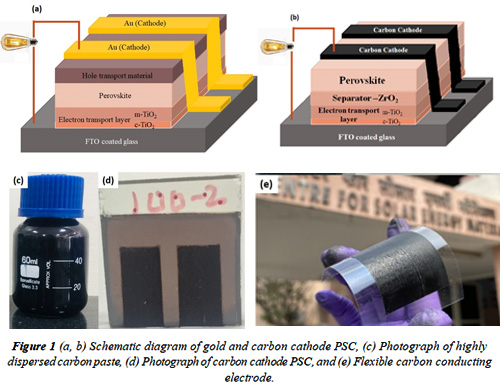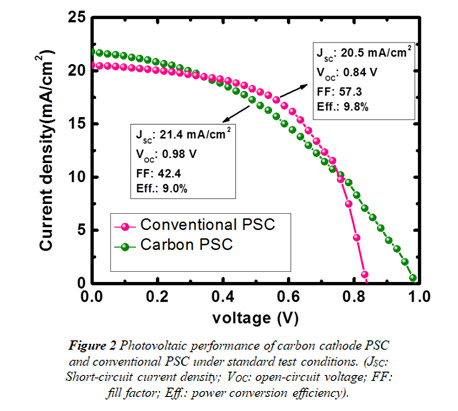 Scientists have developed a highly conductive and stable carbon cathode with low sheet resistance comparable to that of gold that can be processed at room temperature. It could reduce the cost of producing next-generation flexible and lightweight solar cells.
Scientists have developed a highly conductive and stable carbon cathode with low sheet resistance comparable to that of gold that can be processed at room temperature. It could reduce the cost of producing next-generation flexible and lightweight solar cells.
Perovskite solar cell (PSC) is an emerging photovoltaic technology due to simple processing and high power conversion efficiency. The lack of stability and cost of the materials restrict the scaling up of PSCs, which consists of a transparent and conductive substrate, electron transport layer, perovskite absorber, hole transport material--one of the key compounds in it, and a gold cathode. Organic-inorganic perovskites, with a crystal structure of calcium titanium oxide mineral, are unstable under humid conditions as they inherently tend to absorb moisture from the air. The presence of hygroscopic constituents (moisture-retaining) in the hole transporting material (HTM) adds up to the cells' instability. Almost half of the fabrication cost is attributed to organic HTM and metal cathode. Thus replacing them with suitable material can cut down the production cost.
Scientists at the International Advanced Research Centre for Powder Metallurgy and New Materials (ARCI), an autonomous R&D Centre of Department of Science and Technology, Government of India, developed a highly conductive and room temperature curable carbon cathode with a sheet resistance comparable to that of a gold electrode for HTM-free PSCs. The carbon cathode was prepared using cellulose gum, chemically called carboxymethylcellulose (CMC) which is a water-soluble binder. The addition of graphite and carbon black in the optimum ratio almost tripled the conductivity. The binder concentration was controlled to obtain a highly conductive, crack-free adherent carbon film with uniform thickness. This research article was published in the peer-reviewed international journal 'Solar Energy'.
 The carbon cathode used by the ARCI team acts as an encapsulation layer to protect the perovskite from degradation.
The carbon cathode used by the ARCI team acts as an encapsulation layer to protect the perovskite from degradation.
The room temperature processability of the carbon electrode readily allowed the researchers to reproduce the carbon electrode with similar conductivity on cloth and polymer flexible substrates. According to the ARCI team, this work can serve as a benchmark for room temperature curable carbon electrode for next-generation flexible and lightweight solar cells.
Publication Link: doi.org/10.1016/j.solener.2019.05.045
For more details, Dr V. Ganapathy (ganapathy[dot]inspire[at]project[dot]arci[dot]res[dot]in) can be contacted.






























